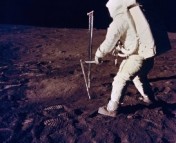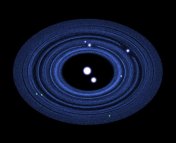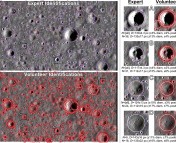Title: Can Moons Have Moons?
Authors: Juna Kollmeier, Sean Raymond
First Author Institution: Observatories of the Carnegie Institution of Washington, Pasadena, California, United States
Status: Published in Monthly Notices of the Royal Astronomical Society [open access]
Our Solar System is home to over 200 moons (and counting!) yet despite centuries of observations, we have yet to find a moon with a moon of its own. The authors of today’s paper investigate what a moon would need in order to host its own moon, or a submoon.
For a moon to stably orbit a planet, or in this case, another moon, it must exist in a delicate region between the planet’s Hill sphere and Roche limit. This area can be thought of as similar to a planet’s Habitable zone, i.e. a set range of radii in space around a celestial body. The Hill sphere is the area around the host body where the dominant gravitational force on the satellite is from the host body itself, rather than any other extraneous objects. To put in the context of our Sun-Earth-Moon system, the Moon is in the Earth’s Hill sphere, which means Earth’s gravitational pull is stronger on the Moon than the Sun’s gravitational pull. The Roche limit is the minimum distance a satellite can orbit at without being torn apart by tidal forces. Tidal forces are the outcome of gravity pulling at the near side of an object stronger than the far side of an object. The rings around Saturn are likely to be moons that got too close to the planet and were ripped apart by these tidal forces.
Figure 1 illustrates the range of possible orbits for the Moon between the Earth’s Hill sphere and the Roche limit. Larger objects have larger Hill spheres, as they have a stronger gravitational influence, meaning there is a larger range for potential moons to have stable orbits. That is why gas giants like Jupiter and Saturn can host so many moons! For moons to host submoons, they need to be at a large distance from their host planet, so that the gravitational pull of their host planet is weaker; otherwise, the moon’s Hill sphere is much too small. This is the problem faced by Uranus and Neptune’s moons, as they all orbit too tightly to their host planet.
The authors’ goal of today’s paper was to map the range of radii in which a submoon would have a stable orbit among the tidal forces present in a planet-moon-submoon system. Figure 2 looks at the moons in our solar system, broken down by planet, and plotted by the size of the moon versus its distance from its host planet. The darkly shaded area in the upper right corner is the zone in which the moon could stably host a submoon with radius 10 km, marked with a dark line. The limit for submoons with radii of 5 km (dotted line) and 20 km (dashed line) are marked as well. This zone was calculated by relating a fixed mass of a theoretical submoon to key properties of the host moon. One of these key properties is the moon’s tidal quality factor Qmoon, which is an indicator of how a specific body/density reacts to tidal forces; rocky bodies generally have a Qmoon= 100 while stars are around 106.
Of all the moons plotted, the only ones capable of hosting submoons were Callisto (Jupiter), Titan and Iapetus (Saturn), and Earth’s own Moon. The authors also looked specifically at the recently discovered exoplanet Kepler-1625b and found its moon capable of hosting a submoon as well.
Figure 3 specifically considers Kepler-1625b and how a potential submoon’s size and tidal quality factor Qmoon would affect its orbit around the moon. On the left graph, the colored lines on the indicate submoons with the mass of specific celestial bodies; submoons of these masses would have a stable orbit if they fall to the right and above the indicated curve. On the right graph, the colored lines indicate different Qmoon values. The left graph held Qmoon at a constant 1000, while the right held the mass constant to that of Ceres. The figures reveal the smaller submoons are stable over a broader range of moon sizes and distance from their host planet, and that a larger Qmoon is equal to a larger “survivability space.”
The question remains: if these moons are all capable of hosting submoons, then why aren’t they? There are several reasons for why this might be. For starters, there are factors that could cause instability in orbits in addition to what was accounted for in the author’s derived equation. In the specific example of Earth’s Moon, the orbits around the Moon are subject to perturbations caused by the Sun and Earth. These perturbations restrict the possible range in which a submoon could stably orbit the moon. Further, submoons could have already formed around the moons mentioned previously, but have since been removed. One theory for this lies with the moon Iapetus, which has a significant ridge along its equator. It’s theorized that a collision with Iapetus produced a submoon, and the debris from the collision was tidally pushed into the moon (causing the ridge), while the submoon itself was tidally pushed outwards.
In summary, a submoon is most likely to have a stable orbit around large moons that are at distant from their host planet. There are many factors that could affect a submoon’s survivability space, so even though we haven’t seen any submoons yet, that does not mean it is not possible. We may even see some in the near future!
Astrobite edited by David Gooding, Haley Wahl
Featured Image Credit: Modified “Earthrise” from NASA




